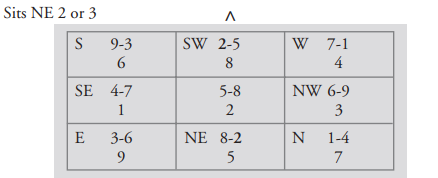
The Fu Mu San Gua house is also referred to as the “3 Period” House or the “Parent String” house. It is a special house type that is often taught as its own case study course in classical Feng Shui curriculums. We have 144 different flying star charts and the Fu Mu San Gua house or “chart type” appears ten times in the whole collection of 144 charts, less than 10% of the total feng shui chart types.
This is a non-obvious distinction, and nothing you can recognize when looking at the house. It can only be calculated based on the year of construction and the compass orientation combined. For example, the house built in Period 5 (1944-1964) and facing southwest between 220-245 degrees, is one of the Fu Mu San Gua Houses. So is a Northeast facing house (between 40-60 degrees), which was built in Period 4 (1924-1944). The chart inserted in this article is another SW-facing chart, from Period 2 (1884-1904).
This house type is considered lucky and I have been asked a number of times if one needs to even bother using remedies on this house type. Of course it needs remedies, as virtually all houses do. Why the folklore about this house type got so extreme, I do not know. In fact, when Master Sang spoke about this house type, he referred to it as “high drama” or the “big surprises” house. This means it can be lucky sometimes and unlucky other times.
The reason it is also called the “3 Period” house is because in each of the eight directions, there is a flying star (representing energy) which is always current or fresh. Out of 3 different flying stars in each area, one of them is going to always have a positive influence. This is compared to other chart types where two or three of the stars may be in a down cycle and potentially trigger negatives events or circumstances.
This 3 Period House ends up being an “ever green” house throughout the entire 180-year cycle that every structure goes through. No matter which of the 9 major 20-Year Eras that we pass through, there will always be something current and positive going on in each directional sector of the floor plan.
It gets a little technical for the casual Feng Shui consumer, but we have 9 Eras and they can be grouped into three categories, called Yuns. One group is called the Upper Yun and consists of Periods 1, 2, and 3. The Middle Yun refers to Periods 4, 5, and 6. And the Lower Yun represents Periods 7, 8, 9.
For the 3 Period House, each of the three stars in every direction is drawn from one of the three major Yun cycles. You will see a pattern where the three stars will be 1-4-7, 2-5-8, or 3-6-9. These number patterns are also found in other esoteric Feng Shui teachings and in other disciplines as well. So for example, if one sector of your house chart has the 1-4-7 combination, the 1 Star is from the Upper Yun, the 4 star is from the Middle Yun and the 7 star is from the Lower Yun. We live in Period 8 from 2004-2024 where the 8, 9, and 1 stars can exert a more positive influence than the other stars.
With the Fu Mu San Gua house, each and every directional sector has an 8, 9, or 1 star. This is what we mean by each direction having one star that is current or fresh. If we can personify the 3 stars in any given location, we could say that one will always be a young baby, another a mature person waning in their positive attributes, and a third person in old age and sickly.
Now, for some sobering observations: With over 5,000 clients since 1992, I have had a lot of experience in the field and I can say that the Fu Mu San Gua house does not seem like a highly unusual house or an extremely lucky house to me. Why? Because there are too many other variables to consider in a comprehensive analysis. For example, a Fu Mu San Gua house in a nice peaceful setting will have a different impact on the occupants than the same house type in a noisy, chaotic environment. Or, a Fu Mu San Gua house with a weird shape will not be as good or stable as a Fu Mu San Gua House that is a simple square or rectangular shape.
There is also a theory that this unique numerical pattern of the flying stars doesn’t really make the structure outstanding in any magnificent way, kind of like our Western calendar months which have 31 days instead of 30 are not “special” months. Why would the 3 Period/Parent String/ Fu Mu San Gua house then become known as a lucky house type? We can speculate until the cows come home, but one theory is that simply pointing out this unique numerical pattern so long ago could have earned a certain Feng Shui master major brownie points with the Chinese emperor, for having “discovered” something really unique and mystical about one house type over another. Perhaps.
Author: Kartar Diamond
Company: Feng Shui Solutions (R)
From the Feng Shui Theory Series
